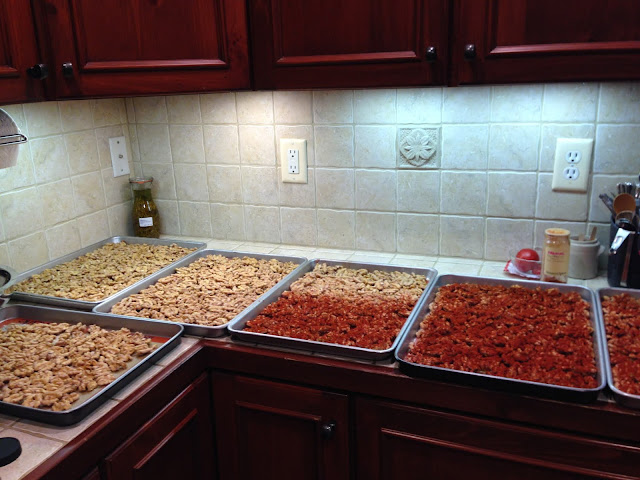If you search the internet for "Houston's Chicken Salad Recipe" there are a multitude of people who have tried to recreate it. I don't believe anyone has gone to the lengths that I have, though, taking the salad home and comparing my dressing attempts to the real thing. After months of trying, here is my best effort.
Houston's Chicken Salad Reverse Engineered
Serves 2 as a main dish, 4 as a side salad
Honey Mustard Dressing:
1/2 c.
mayonnaise
3 t. yellow mustard (I used Whole Food's Organic)
4 t. honey (I used Tropical Traditions Organic)
1 t. apple cider vinegar or lemon juice (I use Natural Nectar Biodynamic ACV)
1/8 t. cayenne
Mix all together and set aside.
Honey Lime Dressing:
1 T. minced shallot, 1/16" mince
1 T. minced red bell pepper, 1/16" mince
1 T. parsley chiffonade
1 t. salt
2 T. honey
3 T. lime juice
1/4 c. organic unrefined safflower oil
Mix together all except the oil and let it sit 1-2 minutes. Whisk in the oil and set aside.
Almond dressing (they used peanuts but it's just as good with almonds)
4 T. water
1 T. minced crystalized ginger, 1/8" mince
2 T. miso tamari or dark soy sauce
1 T.? sriracha
4 T. toasted sesame oil
3 T. almond or peanut butter
1 T. lemon juice
1/2 t. garlic puree
2 T. honey
1 t. apple cider vinegar or lemon juice (I use Natural Nectar Biodaynamic ACV)
Heat the water and ginger and simmer until ginger is softened and water is reduced by half.
Pour into pint jar.
Add remaining ingredients and puree with a stick blender until smooth. Adjust salt and set aside.
Salad:
iceberg or romaine lettuce (should be 1/2 of greens)
green leaf lettuce
red leaf lettuce
butter lettuce
spinach
sorrel
2 leaves red cabbage, sliced 1/16" thin
1 medium carrot sliced into matchstick pieces
1/4 c. cilantro
2 scallions, green tops sliced 1/8" thick
3-4 small tortillas, sliced 1/4" thick
2 T. ghee
grilled chicken breasts (I use canned)
Directions:
Fry the tortillas in the ghee until crisp. Drain on paper towels.
Toss the salad ingredients together.
Drizzle with all three dressings.
Serve with the chicken breasts and tortilla strips on top.















